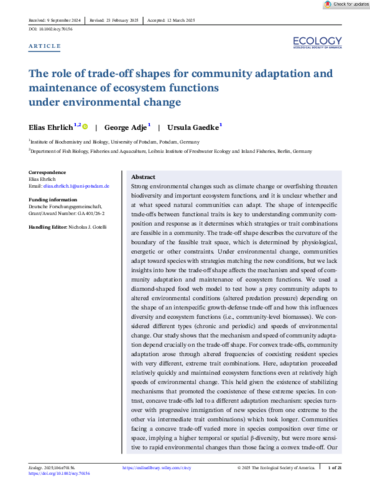Strong environmental changes such as climate change or overfishing threaten biodiversity and important ecosystem functions, and it is unclear whether and at what speed natural communities can adapt. The shape of interspecific trade-offs between functional traits is key to understanding community composition and response as it determines which strategies or trait combinations are feasible in a community. The trade-off shape describes the curvature of the boundary of the feasible trait space, which is determined by physiological, energetic or other constraints. Under environmental change, communities adapt toward species with strategies matching the new conditions, but we lack insights into how the trade-off shape affects the mechanism and speed of community adaptation and maintenance of ecosystem functions. We used a diamond-shaped food web model to test how a prey community adapts to altered environmental conditions (altered predation pressure) depending on the shape of an interspecific growth-defense trade-off and how this influences diversity and ecosystem functions (i.e., community-level biomasses). We considered different types (chronic and periodic) and speeds of environmental change. Our study shows that the mechanism and speed of community adaptation depend crucially on the trade-off shape. For convex trade-offs, community adaptation arose through altered frequencies of coexisting resident species with very different, extreme trait combinations. Here, adaptation proceeded relatively quickly and maintained ecosystem functions even at relatively high speeds of environmental change. This held given the existence of stabilizing mechanisms that promoted the coexistence of these extreme species. In contrast, concave trade-offs led to a different adaptation mechanism: species turnover with progressive immigration of new species (from one extreme to the other via intermediate trait combinations) which took longer. Communities facing a concave trade-off varied more in species composition over time or space, implying a higher temporal or spatial β-diversity, but were more sensitive to rapid environmental changes than those facing a convex trade-off. Our results reveal that knowing the trade-off shape can be important for understanding and predicting community adaptation, functional diversity, and maintenance of ecosystem function under future environmental change.
The role of trade-off shapes for community adaptation and maintenance of ecosystem functions under environmental change
Rezensierter Artikel

Ehrlich, E., Adje, G., & Gaedke, U. (2023). Trade-off shape determines community adaptation and ecosystem functioning under environmental change. Ecology Letters, 26(12), 2197–2211. https://doi.org/10.1111/ele.14305
Veröffentlicht
: 2025
Erschienen in
: Ecology Letters
